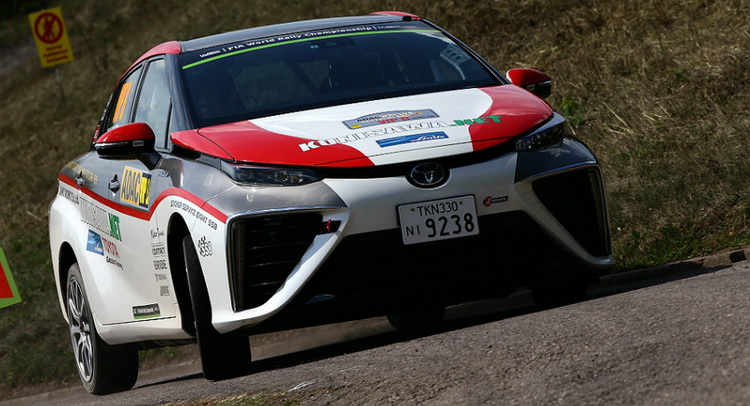Volkswagen may have dominated the ADAC Rallye Deutschland this weekend, with an impressive 1-2-3 for its Polos, but another manufacturer also turned heads, albeit for different reasons.
Toyota did not compete in the event but it has chosen rallying as the field to showcase its commitment to producing sporty cars. Not only has it announced that it will re-enter the World Rally Championship in 2017 with the Yaris WRC, it has also developed an R3-spec GT86 for privateers.
Plus, it appointed none other than four-time world champion Tommi Mäkinen as the head of its factory-backed GAZOO Racing team – and recently had us baffled when we spotted him testing the sole 4×4 GT86 in the world, which was made specifically for company CEO Akio Toyoda, in Finland.
It’s quite fitting, perhaps, that a zero-emissions car was the “zero car”, that is the one that predates the racers at each special stage, in the German rally.
Mitsuhiro Kunisawa, a former motoring journalist who has also competed in the WRC Japan and Asia-Pacific Rally Championship series, was behind the wheel of the Mirai.
The hydrogen fuel-cell saloon was fitted with a roll cage, race seats, upgraded brake pads and, of course, competition tires but, other than that, it was completely stock. That is, the electric motor had the same 113kW (150HP/154PS) output and 9.6 seconds 0-100 km/h (0-62 mph) acceleration time as the production car that is already on sale in Japan and will reach US and European shores this fall.
Toyota Germany was in charge of support, mainly in the form of a mobile hydrogen refuelling unit that can fill the Mirai’s super-strong hydrogen tanks in only three minutes. The Mirai’s Chief Engineer, Yoshikazu Tanaka, commented on the car’s racing debut: “It is our dream that one day our fuel cell vehicles will be able to compete in WRC. Therefore, we will continue to develop this technology with great ambition.”
He also warned that “spectators at the Rallye Deutschland will have to get used to this noiseless premiere at Trier, but they’ll experience the art of an almost pollution-free future.”
Not quite sure about whether that’s an “art”, as far as motorsport enthusiasts are concerned. Formula 1 has already drawn lots of criticism for the lack of aural excitement from the hybrid power units, something the WRC offers in spades.
You can’t fight the future, right? While at the present, though, we can still enjoy the sound of the turbocharged four-cylinder-powered cars driven in anger.









